Simulating top quark production at CERN’s LHC: @mengene's Progress Blog 02 for #citizenscience Project
So it's about time I gave you an update on my #citizenscience journey on Hive with @lemouth and the rest of the incredible @StemSocial community! As my interest in the project rises, it appears that it is already bringing out the particle physicist in me:). With this project, I've gained a greater grasp of how to use the command line. MG5aMC software
I'll dive right into how I went about recreating collisions like the ones that are currently taking place at CERN's Large Hadron Collider. The goal of each of these collisions is to prepare a pair of top quarks (i.e., one top quark and one antitop quark). I'll tell you where I ran into fairly simple problems and how I got out of them so that newbies perhaps won't have to go through the same ordeal!
-> TASK 1 - Top-antitop production at the LHC
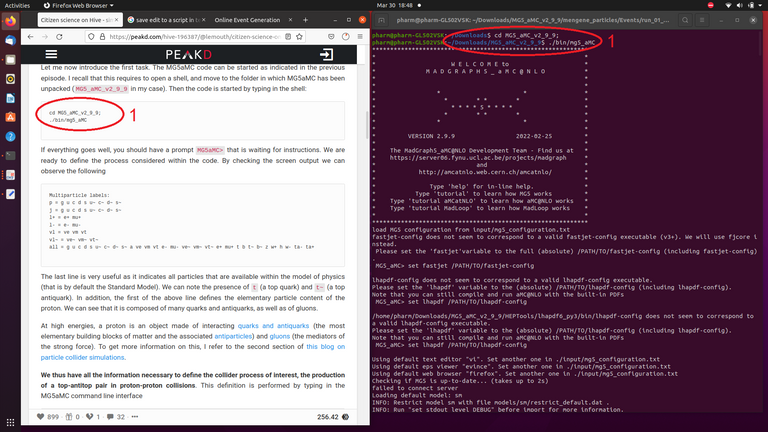
-1: I opened a shell, and moved to the folder in which my MG5aMC has been previously unpacked (i.e. Downloads in my own case). Then I started the code is as shown above
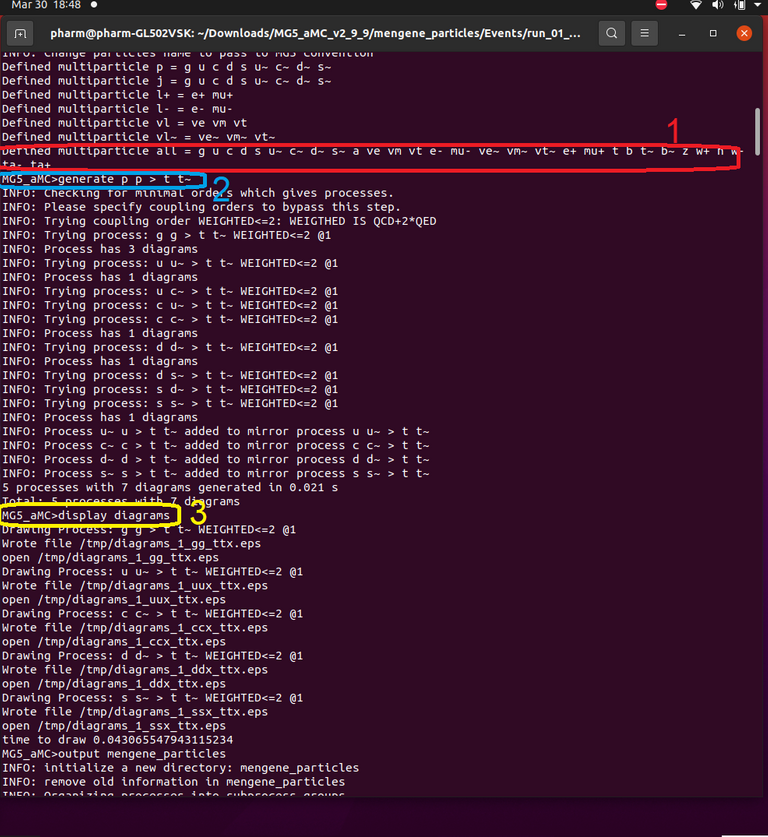
-1: I confirmed the availability of all particles within the Standard model.
-2: I defined the collider process we are interested in simulating via the production of a top-antitop pair in proton-proton collisions.
-3: This line allowed me to see the various options available to produce a top-antitop pair at colliders such as the LHC, from different initial states. I share 2 diagrams that drew my interest below next
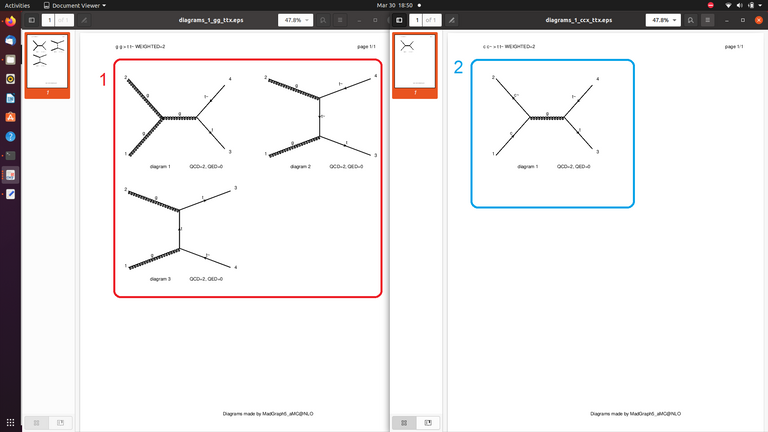
-1: Generated 3 diagrams for g g > t t~
-2: Generated 1 diagram for c c > t t~~
I noted that g g > t t~ was the only possible instance that generated 3 diagrams, i am hoping @lemouth could help explain why this particular instance yielded more than one diagram, which is quite different from the other instances. In addititon, does it mean that if the equation were to be derived from this particular instance would it take just one of the diagrams or it would factor in the other two diagrams during the equation generation process.
-> TASK 2: Run a Fortran code for top-antitop production at the LHC
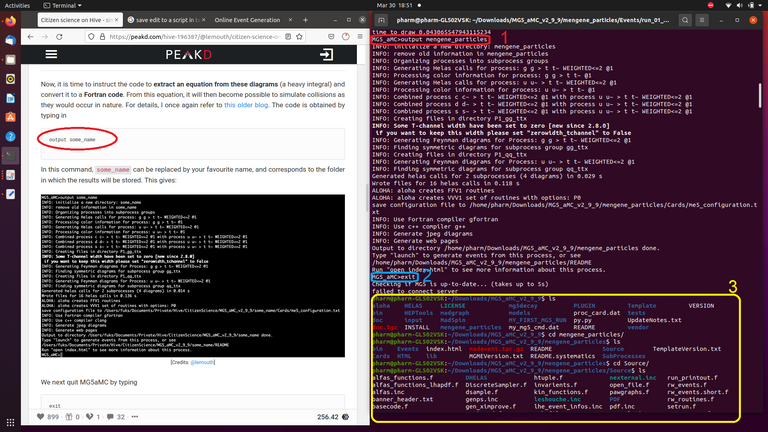
-1 : I instructed the code to extract an equation from these diagrams and convert it to a Fortran code. As stated earlier, this equation will be used to simulate collisions as they would occur in nature.
-2 : I then exited the code
-3 : Being my curious self, I tried to mimic what @lemouth did in the screenshot below, and I managed to open the 'maxparticles.inc' file with a text editor. I share the content of the file in the next picture below
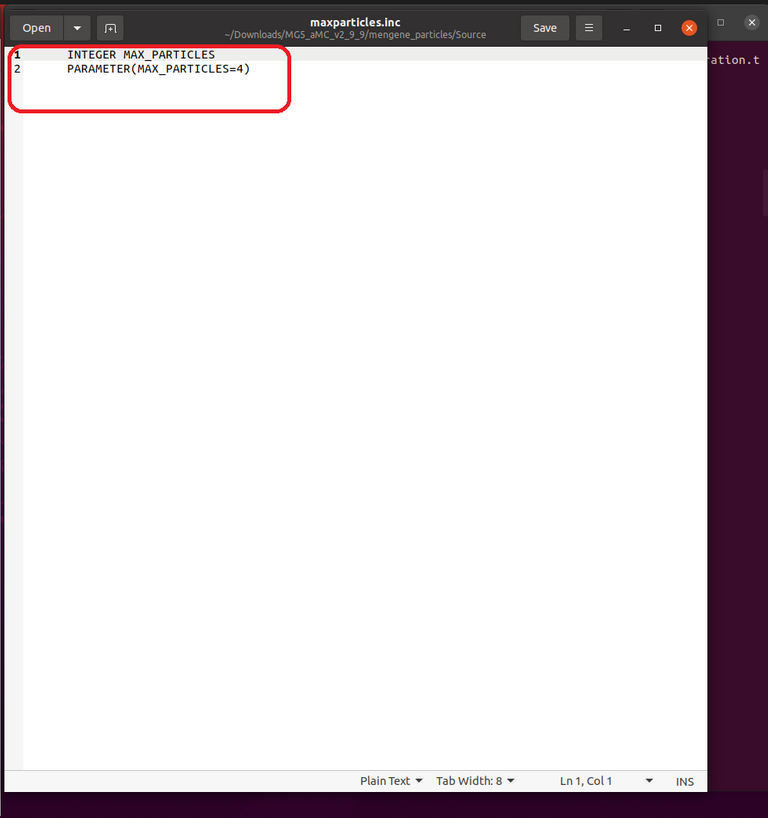
-> TASK 3 : Computing the rate to top-antitop production at the LHC
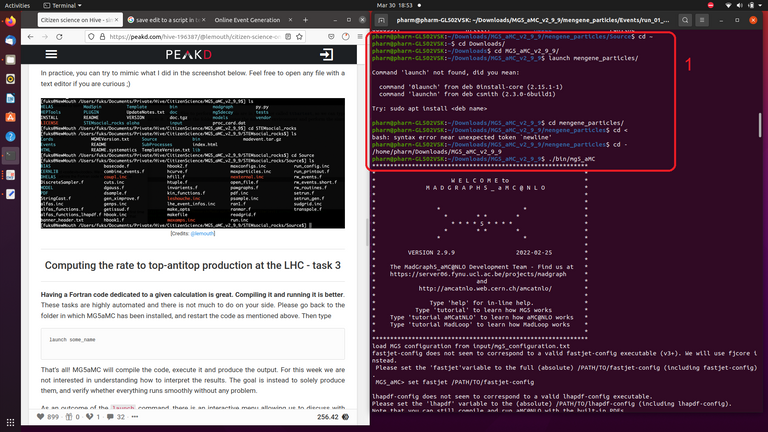
->I tried to Compile the FORTRAN code and run it
-1 : I got the command error because i didn't go back to the folder in which MG5aMC had been installed, and restart the code. Soon as i did the right thing, i was back on track
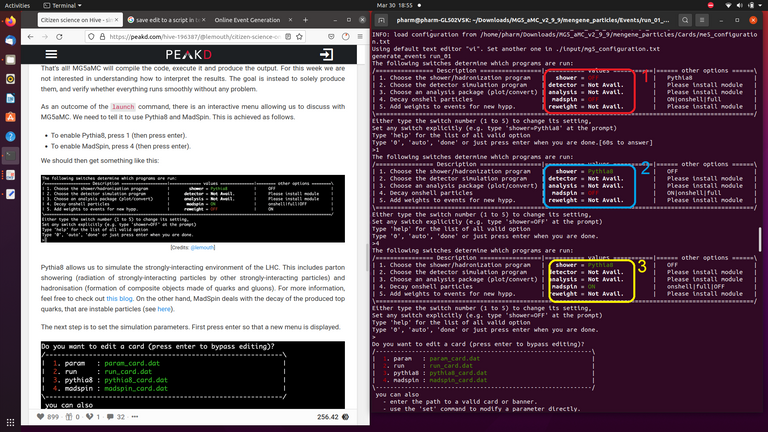
-1 : An interactive menu pops up as a result of running the launch code
-2 : I enabled Pythia8, by pressing 1 , and then 'enter'
-3 : I enabled MadSpin, by pressing 4 , and then 'enter
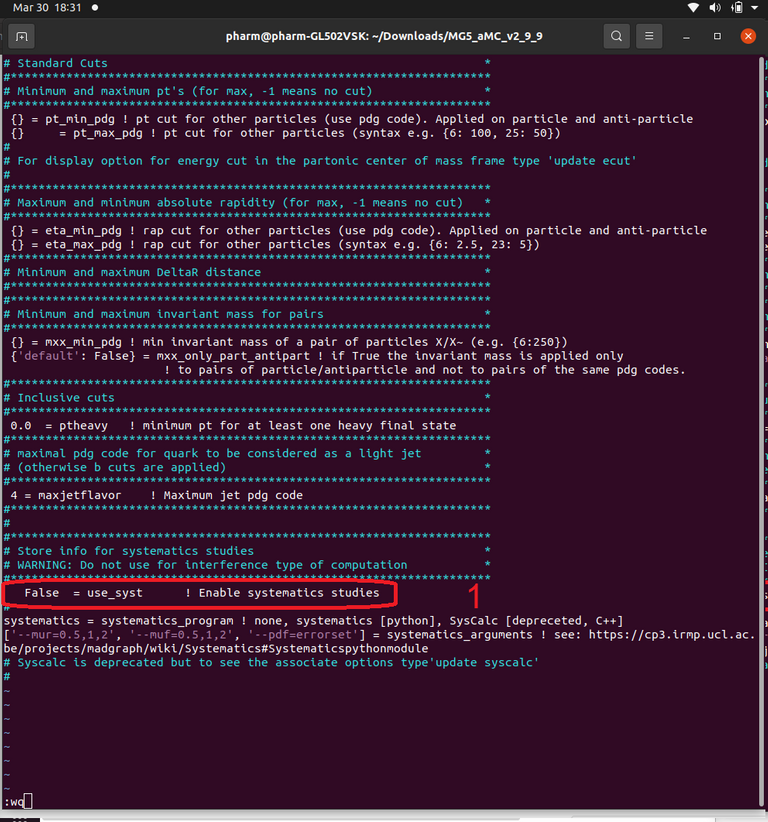
-> I then had to set the simulation parameters.
-1 : I got around editing this line by pressing 2 and enter to open the run_card, then i typed 'i' to insert and make and edit to the file. After which i navigated to the line with the command and changed it from True to False. To save the edit and exit back to the Mag5amc code, i typed in ':wq'

-> I started the simulation and got the number (505.8 ± 0.8033 pb) corresponds to the production rate of a top-antitop pair at the LHC. Pretty close to @lemouth's!
TASK 4 : Checking that everything is ok
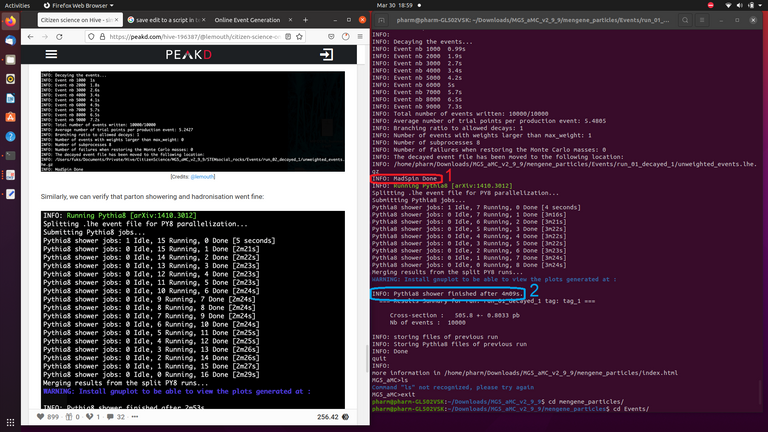
-1 : I verified that MadSpin handled the decay of the produced top quarks and antiquarks as expected
-2 : I verified that pythia8 showering and hadronisation went fine
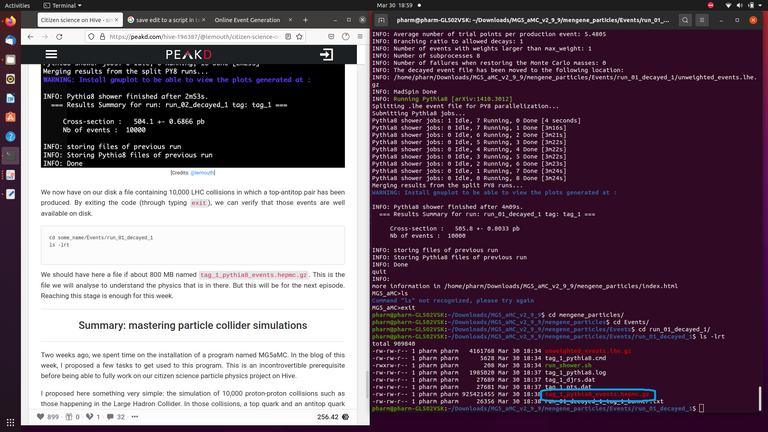
-> I located the file named tag_1_pythia8_events.hepmc.gz just where it ought to be.
And yes! This brings us to the end of the progress report for this week from my end here. It's been quite an eventful evening of particle physics for me, and I already look forward to the next phase of this project.
Have a good one buddies!
Note: All pictures in the blog were generated by my very self!
Posted from HypeTurf
Thanks for your contribution to the STEMsocial community. Feel free to join us on discord to get to know the rest of us!
Please consider delegating to the @stemsocial account (85% of the curation rewards are returned).
You may also include @stemsocial as a beneficiary of the rewards of this post to get a stronger support.
Thanks a lot for this very nice report. It is definitely addressed to everyone: other participants and me (through the few questions). Therefore, it ticks all the boxes :)
First of all, I would like to stress that I really appreciated the figures that you joined to this report. I believe that those with a screenshot of my post on one side and your terminal output on the other side could be very useful for other users, and those with a few things highlighted are very readable too. Thanks for the efforts you put in there!
In addition, it is great to see that you have a 16-cores machine. This will be really helpful for the CPU-heaviest of the next steps. This will allow you to save a lot of time.
Anyway, let me move on with the question you raised.
That’s the mysteries of quantum chromodynamics, the quantum theory describing the strong force. The strong force allows for the following interactions:
In addition, we must keep in mind that protons contain quarks, antiquarks and gluons. The proton content defines the initial state of the different relevant subprocesses. We can have various quark-antiquark pairs, two gluons, or even one gluon and one quark or antiquark. We need to try them all and try to find a (diagrammatic) way, with the above three interactions, to get to a top-antitop final state.
By brute forcing it (note that MG5aMC is a bit more clever than this), we can find quickly that there are 4 possible quark-antiquark initial states that work, respectively with an up, down, strange, and charm flavour. In order to produce a top-antitop final state, we use twice the first of the above interactions (once with a top flavour, and once with the flavour of the initial state), and there is one possibility. This is the diagram that you have found and that is thus four times the same (once for an up-antiup initial state, once for a charm-anticharm initial state, once for a strange-antistrange initial state and once for a down-antidown initial state).
We can also produce a top-antitop pair from two gluons. Here, the above three interactions give 3 possibilities, that are those returned by MG5aMC. Either the first interaction is used twice (both with a top flavour), which gives two diagrams, or we used once the first interaction (with a top flavour) and once the second interaction, which gives the third diagram.
The equation derived from the diagrams is derived from all the diagrams. It would be (totally) incorrect if any diagram would be missing.
Try to open
matrix.f. This will be much funnier ;)Once again, thanks a lot for this very nice report and your questions and comments!
Cheers!
Awesome.. it gets much more interesting! Thanks for explaining in details! I feel i now have a better understanding of the process! and of course, I appreciate the compliments as well! Looking forward to this week's activity!
You are very welcome! I think I will release the next activities on next week (this will give more time to people to proceed). I will however release a weekly post later today about detector simulators, which we will use as well.
Oh, that's great. i look forward to the post about detector simulators
It's alive for a few hours (as it was Monday) ;)
Just popped in! thanks for the update!
Great Post!
!1UP
4minutes,pretty fast
:)
!BEER
Oh really? How many minutes did yours take?
21 min on one server and 10 min on my laptop
!BEER
View or trade
BEER.Hey @mengene, here is a little bit of
BEERfrom @isnochys for you. Enjoy it!Do you want to win SOME BEER together with your friends and draw the
BEERKING.View or trade
BEER.Hey @mengene, here is a little bit of
BEERfrom @isnochys for you. Enjoy it!Learn how to earn FREE BEER each day by staking your
BEER.